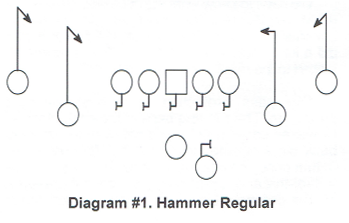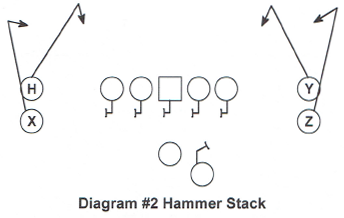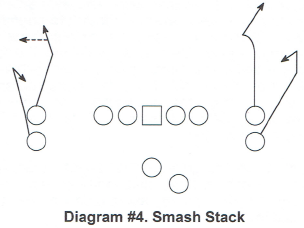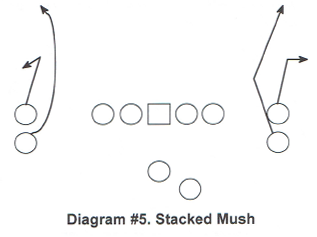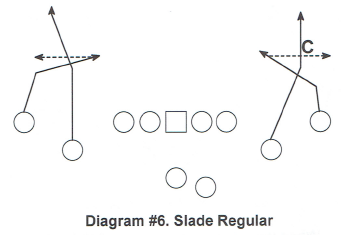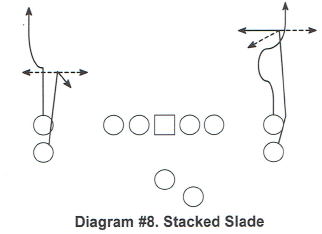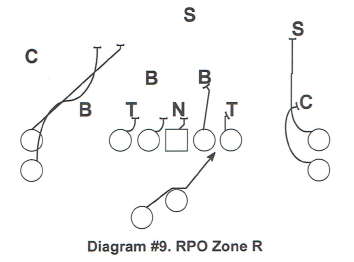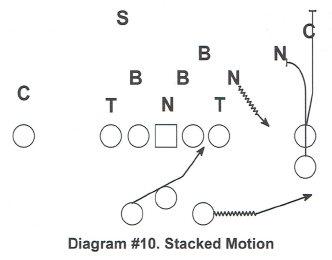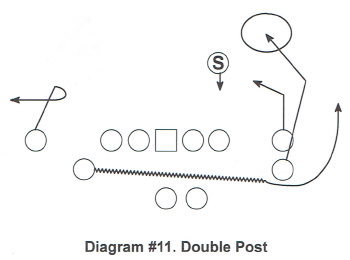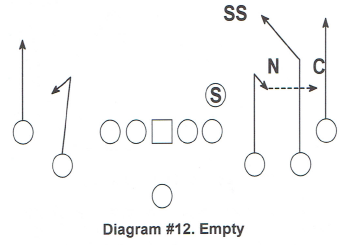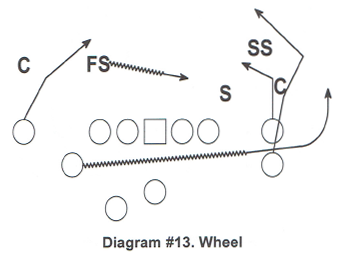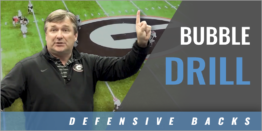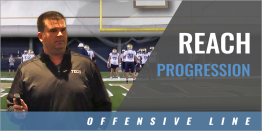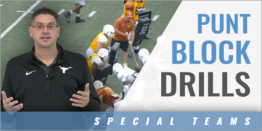|
By: Ben Bailey - Houston County HS (GA) Originally Published in: Nike Coach of the Year Football Clinic Manual Thank you, I am going to get to the topic. I am going to give you two points then we will go through them. We have some concepts that I think are good. We did not have to change anything in our offense. We have mirrored receivers and we tag the receivers if we want to change the pattern.
We did not have to change anything in our passing game offense. When we call these plays, we run mirrored routes or we tag our receivers. Do not worry about the patterns that are shown I will show them to you later. We got minimum looks for the defensive standpoint with their in-game adjustments. We did not do this enough for teams to adjust. We have to know what the overhang players are doing. We also need to know if we can pick on the boundary defenders. That is a short throw. We also did a lot of "check with me" calls. The quarterback looked to the sideline and got a new call. Our pass protection is a base six-man protection. The running back is the sixth blocker. However, some coaches do not want the running back blocking linebackers and defensive ends. In that case, we can free release him. If you have a dual-threat quarterback, you can put pressure on the defense. Last year I had a quarterback that I could not afford to get him hurt, so we did not use the quarterback scramble much. Quick options for the quarterback are always good. If the quarterback was getting pressure. he had the option to throw the quick out pattern. Anything that you can do with your offense, you can do with stacked receivers.
When you get inside the red zone, the stack receivers is a good look for us. People want to know when we use the stacked receiver formation. What I am going to tell you is how we do it. It is not the only way. We use the stacked formation in our first scripted pods. We wanted to see how the defense adjusts to the formation.
We script anywhere between 12-15 plays. I talked to a guy last night who said he did not know what the first play was until he got on the field. All coaches are different as to how they approach that aspect of the game. There are different strokes for different folks. I like to think things through before we get to the field. I want to be organized and have a script of plays. We have pods of 4 to 5 plays. In the script, we use 4 or 5 pods. That gives me from 12-16 plays. We try to show things early to see how the defense is going to align against formations and motion. For my first play, I have a play-action pass. If we make a first down, I move to the second pod of plays. That gives me another first down play. We had a 58 percent completion rate and we ran the ball for a 3.7 yards per carry. That may not sound very good. but we played in a tough conference. We complete 77 percent when throwing our five base concepts. This next topic is some additional information and reminders about the offense.
We allow the quarterback to adjust the splits of the wide receiver into the wide side of the field. That fits his arm strength and the stacked receivers. Time to throw is all with the offensive line. The better we protect, the better we throw. We mixed up the concepts from week to week. We always start with something simple. We usually have four options. We are going to run what we showed in the previous week but add something new to it. We would use the same plays but align to the opposite side. Our players know the concepts, but they are reading grass. (going to the open areas) I am going to show you some clips. They are good and bad. I did not want to show you clips where we completed every pass. That is not the way we play. Our split rules are pretty standard.
You can see the boundary alignment is the bottom of the numbers. To the field, we start at +2 from the hash mark. As the season goes on. we may widen the split to the hash marks. The split into the field depends on the quarterback's arm strength.
The quarterback takes a quick drop step, gather step, and delivers the ball. If he does not have the throw, he wants to throw the ball out of bounds and live to play another day. In the quick game, we married the quick concept with a deep concept. We gave him something short married with something deep. If the quarterback does not deliver the ball on the third step, he is going to step up in the pocket and goes for the deep concept. We tell the quarterback if he does not throw the quick ball, he has to know his out route. We go through all the plays in practice and he knows what we are going to run out of the stack. He knows his out on the quick game is the post route. The quarterback is going to throw the post where our receiver can catch it. If he does not catch it, it is not a wasted play. We live to play another play. We tell the quarterback not to take a sack, but it happens sometimes. The first route I want to show you is called "hammer." It is an all hitch pattern. Hammer
The point receiver takes a MIR release. (Diagram #1) MIR stands for (Mandatory Inside Release.)
The love route means the receiver is not the number one receiver on the play, but he has to run his route to open up the other receiver. He has to bust his butt. This is a regular formation. This is what the play looks like if we run it out of the double set. We usually run it from the 3x1 set. When we go to the stack formation the inside receiver in the regular set is the point receiver in the formation. He aligns on the line of scrimmage. In the stack formation, the X-receiver is the stacked receiver. (Diagram #2) The H-back is the point receiver to this side. To the other side, we have a mirrored set. The Z-receiver is the stacked receiver and the Y-tight end is the point receiver. The outside receivers in a regular set are the stacked receivers. They are behind the slot receiver.
When we run the Hammer, the point receiver must get an inside release. He is probably not going to get the ball unless the defenders are playing catch techniques. Everyone on the Hammer is running a six-yard hitch. The defender aligned on the point receiver may fight him off the ball, which gives our back receiver a free release. He runs an outside hitch. The next thing we want to deal with is "Smash/ Mush." Everyone runs the "Smash" concept. The outside receiver runs the hitch and the inside receiver runs the corner route. The "Mush" pattern for us is the exact opposite of the smash. All our rules stay the same for all our players. Smash/Mush
If we run the pattern in a regular 2x2 formation, it looks like a typical smash play. (Diagram #3) The outside receiver runs the hitch and the inside receiver runs the corner. He can run a corner and break it to the post with a quarterback signal.
The patterns are no different in the stacked formation. We are still running the hitch and corner. When we run the smash route, the stacked receiver is going to run the wide departure hitch. (Diagram #4) If we thought the point defender was walling off the point receiver, we converted the pattern to the mush part of the pattern. They switch their patterns. The point receiver runs the hitch and the back receiver runs the corner.
To the boundary side of the formation. based on the leverage of the safety, the corner receiver has the option of running a corner-post route. However. that route change comes from the quarterback by way of a signal. We were not too successful with the deep pass game, but I think this opened it up. This pattern gives us a good quick option. The corner route should be thrown between 2 and 2.3 seconds. The corner pattern can be cut down to a 15 yard out cut. If we run the "Mush' concept from the stack formation, (Diagram #5) the point receiver runs the hitch route and the rear receiver runs the corner route. The corner receiver can cut his pattern off and take it to the sidelines.
The routes are the same from a regular 2x2 formations. The reason to run the mush was the play of the defender over the point receiver. What they wanted to do was punch the point receiver then catch the X-receiver running the hitch inside. Now, if they punch the point and try to catch the X-receiver. we get a good corner route on him. The smash and mush concepts are better into the boundary. Our short passing game became a lot of our running game. Our offensive line was on the smallish side. The right side of our offensive line averaged about 215 pounds. We could pass block but run blocking was a challenge against the teams we played. We felt like the wider the hitch could get the better it was for us. If the hitch runner is covered up and is not going to get the ball, he wants to continue to work for width and open up more space for the corner receiver. Now we are going to talk about "Squeeze/ Slade". Slade was our slant/fade concept. This pattern is something you would probably see at a college level. Squeeze/Slade
When we run the Slade from a regular 2x2 set. the outside receiver (Z) is aligned at the top of the numbers. (Diagram #6) The inside receiver (Y) is splitting the distance. The inside receiver runs at the inside number of the corner. The outside receiver runs a four-step slant. If the flat defender has settled and is waiting for him. He plants and runs a snag route back to the outside.
These plays complement each other. On the stacked Slade, the point receiver takes an inside release and he is going to run a fade. (Diagram #7) His aiming point is still at the inside number of the corner. The stack receiver releases outside and up the field before he comes inside on the slant. If a defender is playing the slant, he has the option to run the snag route back to the sidelines.
On the squeeze play, the point receiver is going to run a fade route. (Diagram #8) The stack receiver is not going to outside release. He is going to run an "in" route or some combination route. The stacked receiver is following the point receiver down the field. The stack receiver is going to run his pattern off the grass. Wherever the open grass is will be where he ends up. It could be an in, hitch, or working outside.
You can install these things in a couple of days and make it part of your offense. It is something that you can use to give you another wrinkle in your offense. It is really simple. Before I quit, I want to show you some of our RPO game. We run the zone read play. (Diagram #9) If we run the zone play right, the quarterback keys the backside C-gap player. If he does not think the defender can make a play, he leaves the ball with the running back. If it looks as if the defender can make the play, he pulls the ball.
One other thing you can use to your advantage is the splits of the outside receivers. The defensive backs cover on the outside have a different angle when coming to tackle the football. One of the plays we run in conjunction with this offense is the now screen. The quarterback runs the zone fake and throws it to the stacked receiver in the tandem. It is an easy play to complete and you have one blocker. You can block the corner and let the receiver get what he can. I want to show the motion we used with the stacked formation. We use this motion to isolate some of our players. We align in 20 personnel, which is two backs and no tight end. (Diagram #10) When we used the motion, we pulled the flat defender to the motion and completed the ball to the stacked receiver on a run to grass pass.
We can use motion to isolate a backside receiver or complement the stacked. (Diagram #11) We align in a 2x2 with the stacked receivers to the right. The slot back on the left side comes in motion and will run a wheel route on the other side of the stacked receivers. With the stacked receiver we run a double post to the middle. The first post is to tempt the safety to drop down on the receiver running to the post. We try to sneak the second wide receiver into the middle behind the safety.
We can use the RPO to set up a screen. If we run the RPO and get a pull the ball key. the quarterback pulls the ball and throws it to the stacked receiver into the sideline. We have a lead blocker in the point receiver. We get what we can after that. I want to show you a simple pattern we run from an empty set. (Diagram #12) It is a drop-back pass. We have three receivers to the wide side of the field. We are looking for the inside receiver. The two outside receivers run post routes to the inside. The inside receiver matches up on the linebacker. He is going to run a choice route. If he is a zone player, the receiver runs a stick route. If it is man to man. he runs an out route. That route is almost a pick play with the outside receiver running up the field.
If you have a quarterback that can run the ball this is some really good stuff. I want to show you this last play. (Diagram #13) We use motion to get into a 3x1. The stacked receivers run a double post and the motion receiver runs a wheel route. This is a good play because the defense loses the wheel route.
Does anyone have any questions? I think you can take the Hammer, Smash/Mush. and Squeeze/Slade and give you a wrinkle in your offense. They are not hard to install, and it has been effective for us. Thank you for your time. |



